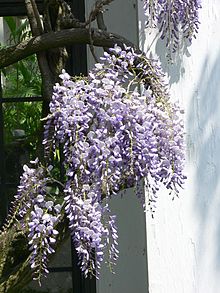| Japanese wisteria | |
|---|---|

| |
| Longwood Gardens, Pennsylvania | |
| Scientific classification | |
| Kingdom: | Plantae |
| Clade: | Tracheophytes |
| Clade: | Angiosperms |
| Clade: | Eudicots |
| Clade: | Rosids |
| Order: | Fabales |
| Family: | Fabaceae |
| Subfamily: | Faboideae |
| Genus: | Wisteria |
| Species: | W. floribunda
|
| Binomial name | |
| Wisteria floribunda | |
Wisteria floribunda, common name Japanese wisteria (藤, fuji), is a species of flowering plant in the family Fabaceae, native to Japan.[1] (Wisteriopsis japonica, synonym Wisteria japonica, is a different species.) Growing to 9 m (30 ft), Wisteria floribunda is a woody, deciduous twining climber. It was first brought from Japan to the United States in the 1830s.[2][3] It is a common subject for bonsai, along with Wisteria sinensis (Chinese wisteria).[citation needed]
Japanese wisteria sports the longest flower racemes of any wisteria; Some of those cultivars can reach 2 m (7 ft) in length.[4][5] These racemes burst into clustered white, pink, violet, or blue flowers in early- to mid-spring. The flowers carry a fragrance similar to that of grapes. The early flowering time of Japanese wisteria can cause problems in temperate climates, where early frosts can destroy the coming years' flowers. It will also flower only after passing from juvenile to adult stage, a transition that may take many years just like its cousin Chinese wisteria.
Japanese wisteria can grow over 30 metres (98 ft) long over many supports via powerful clockwise-twining stems. The foliage consists of shiny, dark-green, pinnately compound leaves 10–30 centimetres (3.9–11.8 in) in length. The leaves bear about 15-19 oblong leaflets[6] that are each 2–6 centimetres (0.79–2.36 in) long. It also bears poisonous, brown, velvety, bean-like seed pods 5–10 centimetres (2.0–3.9 in) long that mature in summer and persist until winter. Japanese wisteria prefers moist soils and full sun in USDA plant hardiness zones 5–9.[7] The plant often lives over 50 years.
- ^ "Japanese wisteria". Britannica. Retrieved April 25, 2021.
- ^ "Wisteria floribunda, W. sinensis". United States Forest Service. Retrieved December 12, 2014.
- ^ "Japanese Wisteria". National Park Service. Retrieved December 12, 2014.
- ^ "Japanese wistaria, Wisteria floribunda (Willd.) DC". Japan knowledge.com. Archived from the original on 15 May 2021.
- ^ Cite error: The named reference
jataffwas invoked but never defined (see the help page). - ^ "Wisteria floribunda", North Carolina Extension Gardener Plant Toolbox, NC State University and N.C. A&T State University, retrieved 2023-05-19
- ^ Purple Patches Japanese Wisteria (includes some growth conditions and US region map) www.monrovia.com, accessed 13 May 2020